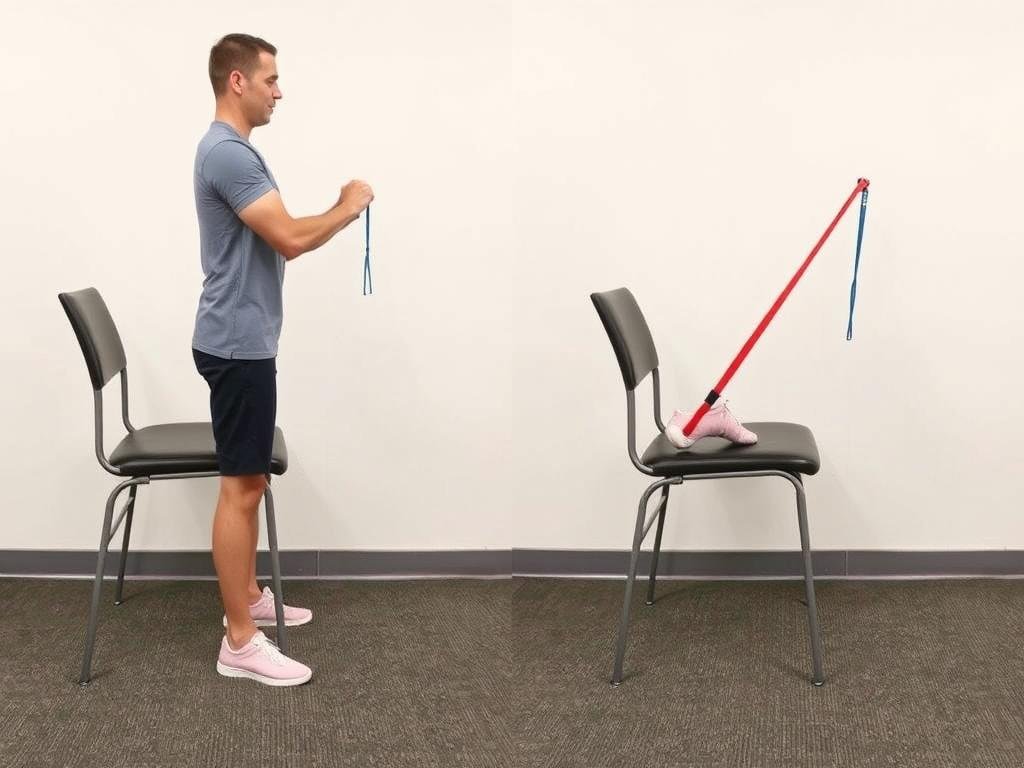
Recovering from a knee injury requires patience, consistency, and proper technique. Whether you’re dealing with a minor sprain or post-surgical rehabilitation, following a structured exercise program is crucial for restoring strength, flexibility, and function. This comprehensive guide walks you through progressive knee injury recovery exercises step by step, helping you safely navigate each phase of rehabilitation. Remember that proper form and gradual progression are key to avoiding setbacks and achieving optimal results.
Understanding the Knee Rehabilitation Process
Knee rehabilitation typically progresses through three distinct phases, each with specific goals and appropriate exercises. Understanding this progression helps you recognize where you are in your recovery journey and what to expect next.
The three phases of knee rehabilitation: from basic mobility to full function
Why Proper Exercise Progression Matters
Rushing through rehabilitation can lead to setbacks or even new injuries. Each phase builds upon the previous one, gradually increasing the demands on your healing knee. Skipping phases or attempting advanced exercises too soon can compromise your recovery and prolong your rehabilitation time.
Important: Before starting any knee rehabilitation program, consult with your healthcare provider or physical therapist. They can provide personalized guidance based on your specific injury, medical history, and recovery goals.
Early-Stage Recovery Exercises
The initial phase of knee rehabilitation focuses on reducing swelling, minimizing pain, and restoring basic range of motion. These gentle exercises can typically begin within days of injury or surgery, depending on your doctor’s recommendations.
Heel slides help restore range of motion during early recovery
1. Heel Slides
Purpose: Improve knee flexion and restore range of motion
- Lie on your back on a flat surface with both legs extended.
- Slowly bend your affected knee by sliding your heel toward your buttocks.
- Slide as far as you can without pain, then hold the position for 5 seconds.
- Slowly return to the starting position by sliding your heel back out.
- Repeat 10-15 times, 3 sets, twice daily.
Tip: Place a small towel under your heel to reduce friction and make the movement smoother.
2. Quadriceps Sets
Purpose: Activate and strengthen the quadriceps muscles without moving the knee joint
- Sit or lie on your back with your injured leg straight out in front of you.
- Place a small rolled towel under your knee for support.
- Tighten the muscles on top of your thigh by pushing the back of your knee down toward the towel.
- Hold the contraction for 5-10 seconds while breathing normally.
- Relax completely between repetitions.
- Repeat 10 times, 3 sets, 3-4 times daily.
Tip: Focus on the muscle contraction rather than lifting your leg.
3. Ankle Pumps
Purpose: Improve circulation and reduce swelling in the lower leg
- Lie on your back with your legs extended.
- Slowly pull your foot toward you, then push it away from you.
- Move only at the ankle joint, keeping your knee still.
- Repeat 20-30 times, every hour while awake.
Tip: This exercise can be performed even when wearing a knee brace.
4. Seated Knee Extensions
Purpose: Improve knee extension and quadriceps strength
- Sit in a chair with your feet flat on the floor.
- Slowly straighten your affected knee until your leg is as straight as possible.
- Hold for 5 seconds, focusing on tightening your thigh muscle.
- Slowly lower your foot back to the floor.
- Repeat 10 times, 3 sets, twice daily.
Tip: Avoid locking your knee at full extension.
Caution: Stop any exercise that causes sharp pain, increased swelling, or joint instability. Some mild discomfort is normal, but pain is a warning sign that should not be ignored.
Not Sure If You’re Doing These Exercises Correctly?
Proper technique is crucial for effective knee rehabilitation. A physical therapist can assess your specific injury, provide personalized guidance, and ensure you’re performing exercises correctly to maximize recovery and prevent further injury.
Intermediate Recovery Exercises
Once swelling has decreased and basic range of motion has improved, you can progress to intermediate exercises that focus on building strength and stability. These exercises typically begin 2-6 weeks after injury or surgery, depending on your recovery progress.
Standing hamstring curls with resistance bands build strength during intermediate recovery
1. Standing Hamstring Curls
Purpose: Strengthen hamstring muscles and improve knee flexion
- Stand facing a wall or chair for support.
- Shift your weight onto your unaffected leg.
- Slowly bend your affected knee, bringing your heel toward your buttocks.
- Hold for 3-5 seconds at the top of the movement.
- Slowly lower your foot back to the floor.
- Repeat 10-15 times, 3 sets, once daily.
Progression: Add an ankle weight or resistance band for increased difficulty.
2. Mini Squats
Purpose: Strengthen quadriceps, hamstrings, and glutes while improving knee stability
- Stand with your feet shoulder-width apart, holding onto a stable surface for balance if needed.
- Slowly bend your knees to lower your body about 6-8 inches (as if sitting down in a chair).
- Keep your back straight and ensure your knees don’t extend past your toes.
- Hold for 3 seconds, then slowly return to standing.
- Repeat 10 times, 3 sets, once daily.
Tip: Keep your weight in your heels rather than on your toes.
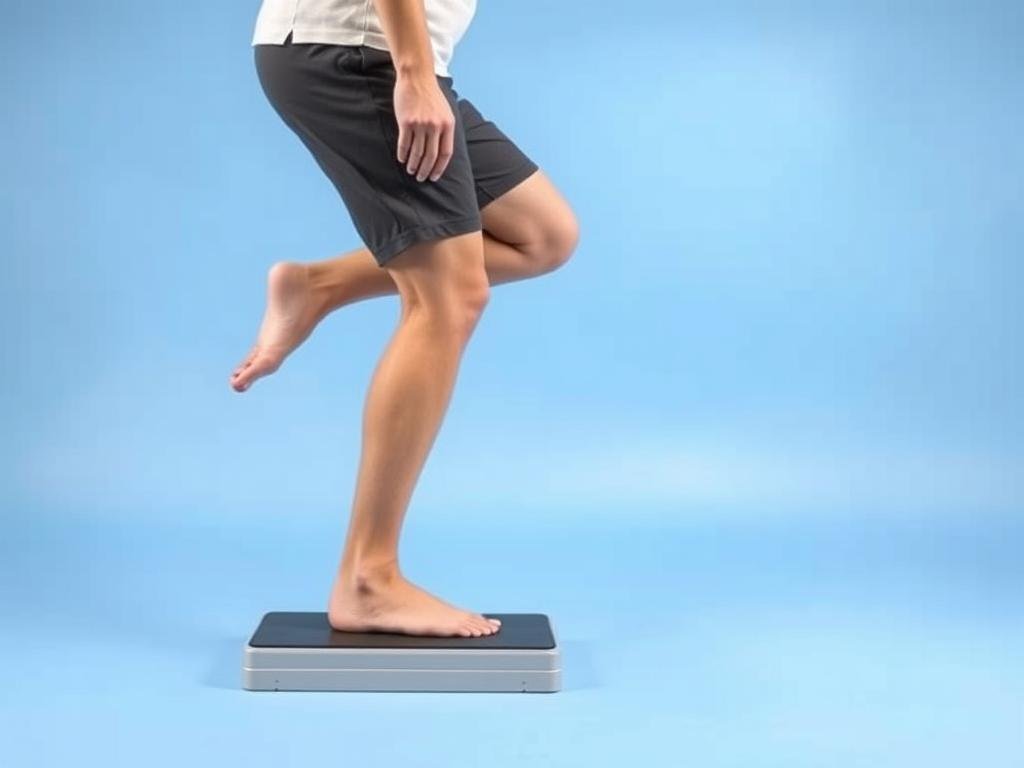
Step-ups strengthen the quadriceps and improve functional stability
3. Step-Ups
Purpose: Build leg strength and improve functional stability
- Stand facing a small step or sturdy platform (4-6 inches high).
- Place your affected foot fully on the step.
- Slowly straighten your knee to lift your body up onto the step.
- Slowly lower back down, controlling the movement.
- Repeat 10 times, 3 sets, once daily.
Progression: Increase the height of the step or add hand weights as strength improves.
4. Straight Leg Raises
Purpose: Strengthen quadriceps without bending the knee
- Lie on your back with your unaffected knee bent and foot flat on the floor.
- Keep your affected leg straight.
- Tighten the thigh muscles of your straight leg and lift it to the height of your bent knee.
- Hold for 5 seconds, then slowly lower.
- Repeat 10 times, 3 sets, once daily.
Tip: Keep your back flat against the floor throughout the exercise.
“Consistency is more important than intensity during knee rehabilitation. Performing moderate exercises regularly yields better results than occasional intense workouts.”
Advanced Recovery Exercises
Advanced exercises focus on restoring full function, improving coordination, and preparing you for a return to normal activities. These exercises typically begin 6-12 weeks after injury or surgery, once you’ve built a foundation of strength and stability.
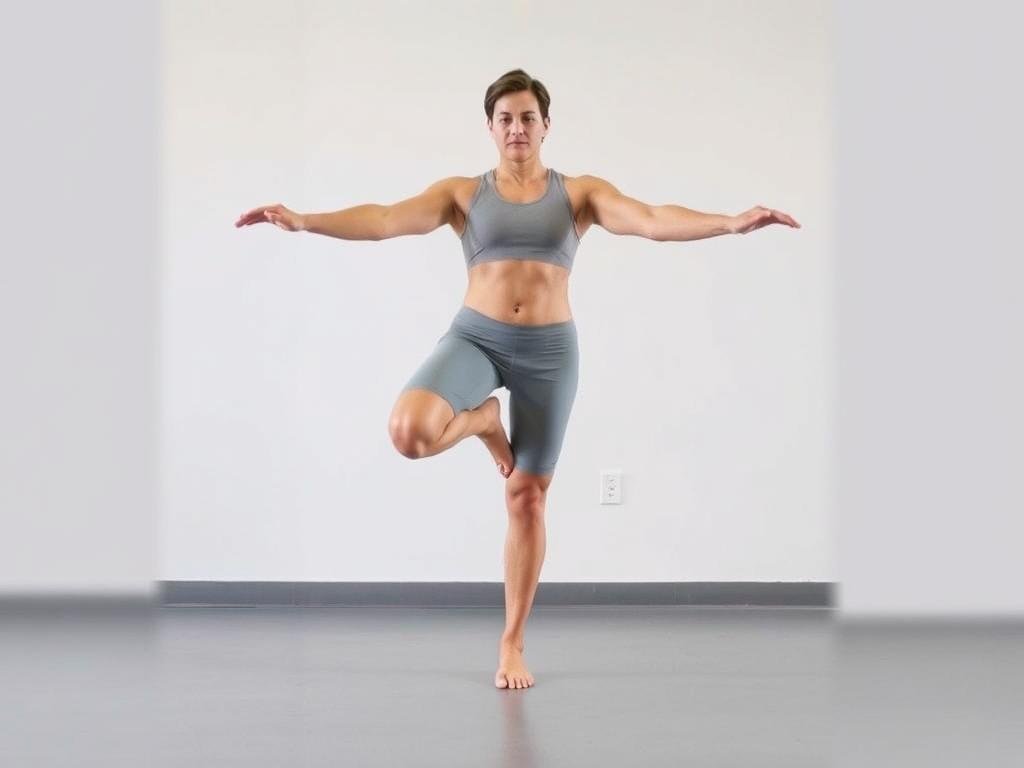
Single-leg balance exercises improve proprioception and stability
1. Walking Lunges
Purpose: Build strength, stability, and coordination in a functional movement pattern
- Stand with your feet hip-width apart.
- Take a controlled step forward with your right foot.
- Bend both knees to lower your body, creating two 90-degree angles with your legs.
- Push through your right heel to stand and bring your left foot forward into the next lunge.
- Alternate legs, performing 10 lunges on each side, 3 sets.
Tip: Keep your torso upright and ensure your front knee stays aligned with your ankle.
2. Single-Leg Balance
Purpose: Improve proprioception (joint position sense) and stability
- Stand near a wall or chair for support if needed.
- Shift your weight onto your affected leg.
- Lift your unaffected foot off the ground, balancing on one leg.
- Hold for 30 seconds, working up to 1 minute.
- Repeat 3 times, once daily.
Progression: Close your eyes or stand on an unstable surface (like a folded towel) to increase difficulty.
3. Lateral Step-Ups
Purpose: Strengthen hip abductors and improve lateral stability
- Stand with your affected leg closest to a step or platform.
- Place your affected foot fully on the step.
- Push through your heel to lift your body up onto the step.
- Slowly lower back down, controlling the movement.
- Repeat 10 times, 3 sets, once daily.
Tip: Keep your hips level throughout the movement.
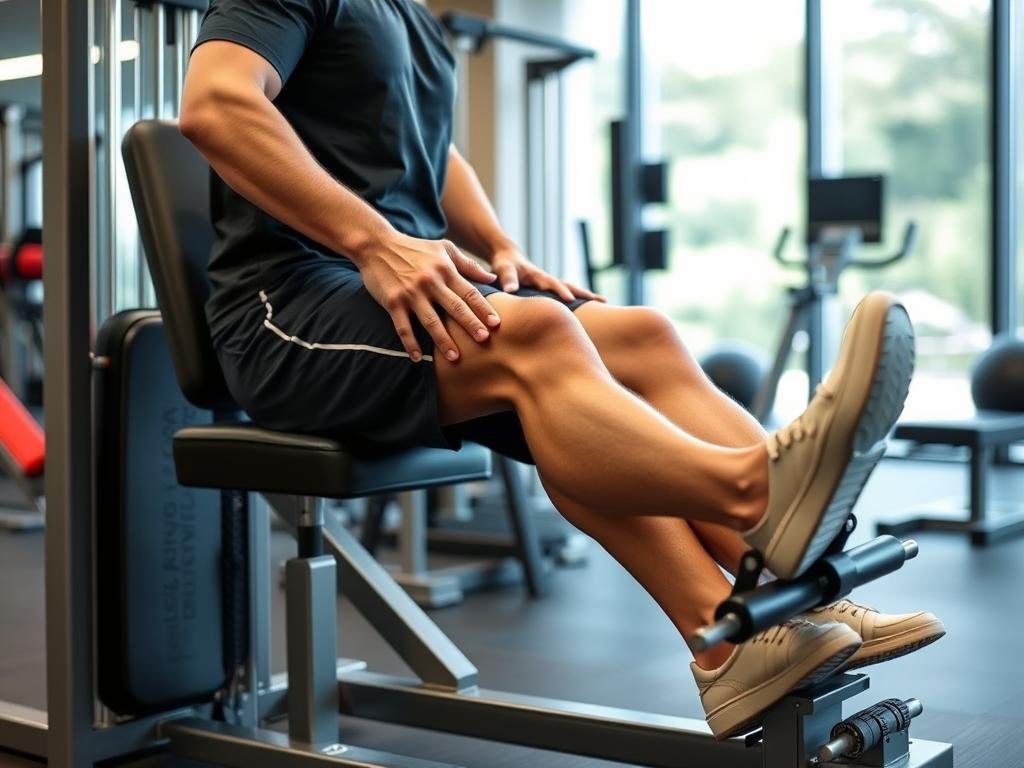
Leg press exercises build strength while controlling range of motion
4. Leg Press
Purpose: Build overall leg strength in a controlled environment
- Sit on a leg press machine with your back against the pad.
- Place your feet hip-width apart on the platform.
- Slowly bend your knees to lower the weight, stopping at about 90 degrees.
- Push through your heels to extend your legs without locking your knees.
- Repeat 10-12 times, 3 sets, 2-3 times weekly.
Tip: Start with light weight and focus on proper form before increasing resistance.
Essential Stretching Exercises
Stretching is a crucial component of knee rehabilitation at all stages. These exercises help maintain and improve flexibility, prevent muscle tightness, and support overall knee function.
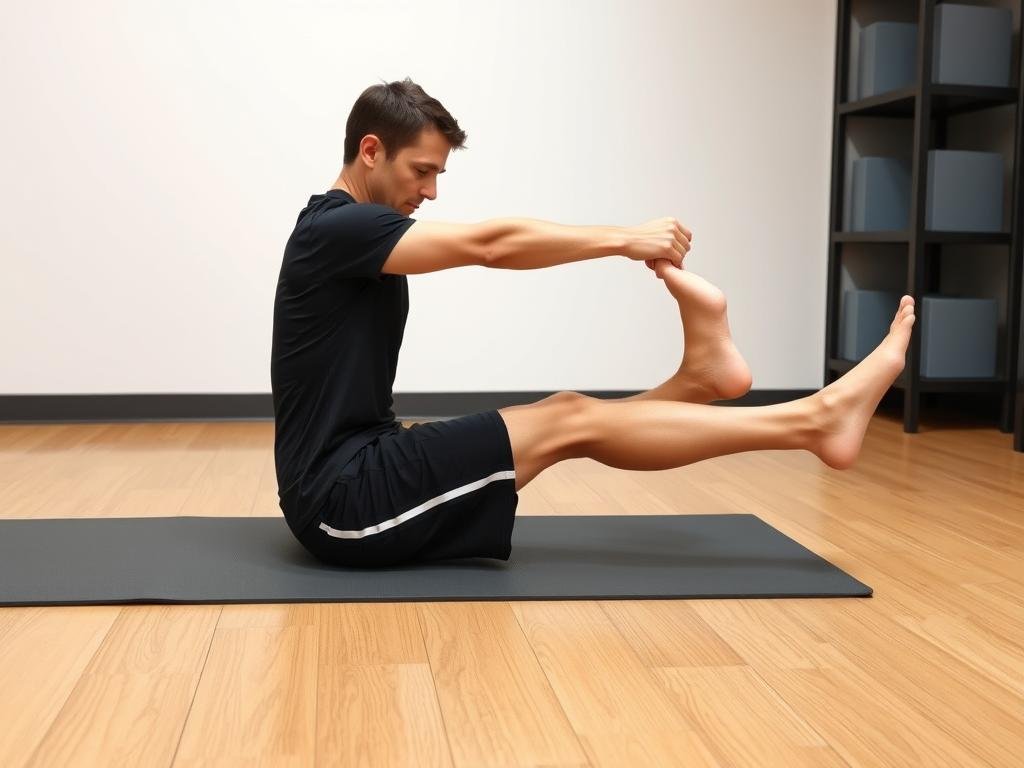
Regular hamstring stretching helps maintain flexibility and reduce strain on the knee
1. Hamstring Stretch
Purpose: Reduce tension in the hamstrings that can affect knee movement
- Sit on the edge of a chair with your affected leg extended, heel on the floor.
- Keep your back straight and bend forward at the hips until you feel a stretch in the back of your thigh.
- Hold for 30 seconds, breathing normally.
- Repeat 3 times, twice daily.
Tip: Avoid bouncing during the stretch.
2. Quadriceps Stretch
Purpose: Improve flexibility in the front thigh muscles
- Stand near a wall or chair for support.
- Bend your affected knee and grasp your ankle or foot with your hand.
- Gently pull your heel toward your buttocks until you feel a stretch in the front of your thigh.
- Keep your knees close together and maintain an upright posture.
- Hold for 30 seconds, then release.
- Repeat 3 times, twice daily.
Tip: If you can’t reach your foot, use a towel or strap to help.
3. Calf Stretch
Purpose: Reduce tension in the calf muscles that can affect knee mechanics
- Stand facing a wall with your hands at eye level.
- Place your affected leg behind you with the heel on the floor.
- Bend your front knee while keeping your back leg straight.
- Lean forward until you feel a stretch in your calf.
- Hold for 30 seconds, then release.
- Repeat 3 times, twice daily.
Tip: Keep both feet pointing forward and your back heel on the ground.
Safety Tips for Knee Rehabilitation
Proper technique and safety awareness are essential for effective knee rehabilitation. Follow these guidelines to minimize risk and maximize recovery benefits.
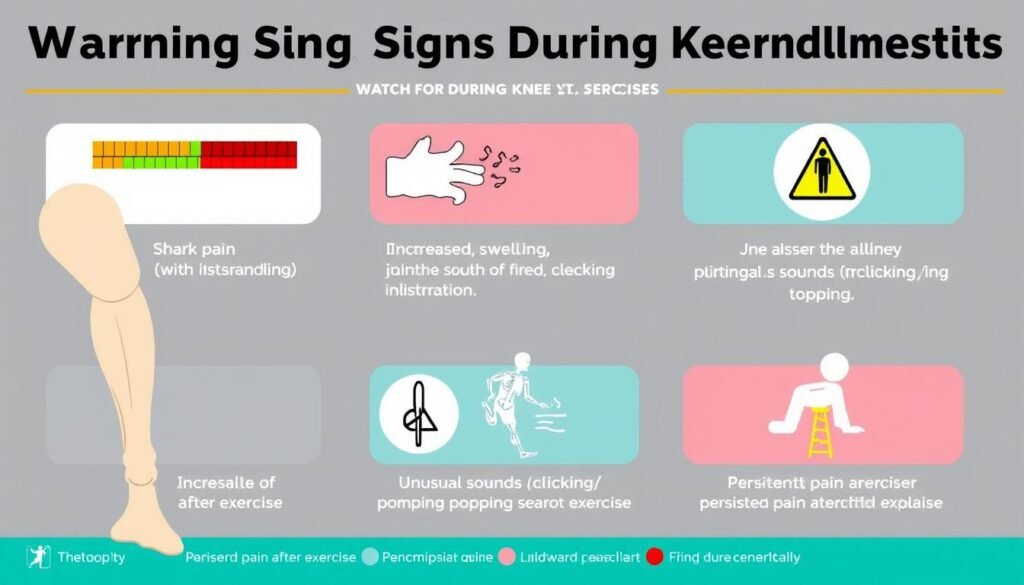
Warning signs to watch for during knee rehabilitation exercises
Warning Signs to Watch For
- Sharp Pain: Mild discomfort is normal, but sharp pain indicates you should stop the exercise immediately.
- Increased Swelling: Some temporary swelling after exercise is normal, but significant or persistent swelling requires medical attention.
- Joint Instability: Feelings of “giving way” or instability during exercises warrant professional evaluation.
- Unusual Sounds: New clicking, popping, or grinding sounds during movement should be reported to your healthcare provider.
- Persistent Pain: Pain that continues for hours after exercise or worsens over time requires medical attention.
General Safety Guidelines
- Warm Up: Always begin with 5-10 minutes of gentle activity like walking or stationary cycling to increase blood flow.
- Proper Form: Focus on quality over quantity. Proper technique prevents additional injury.
- Gradual Progression: Increase repetitions, sets, or resistance gradually, not all at once.
- Rest Days: Allow 24-48 hours between strength training sessions for the same muscle groups.
- Ice After Exercise: Apply ice for 15-20 minutes after exercise if you experience mild swelling or discomfort.
Important: If you experience persistent pain, significant swelling, or instability during or after exercises, consult your healthcare provider immediately. These symptoms may indicate that the exercise is too advanced or that there’s an underlying issue that needs attention.
Creating Your Rehabilitation Routine
A consistent, well-structured exercise routine is key to successful knee rehabilitation. Here’s how to create an effective program that progresses appropriately with your recovery.
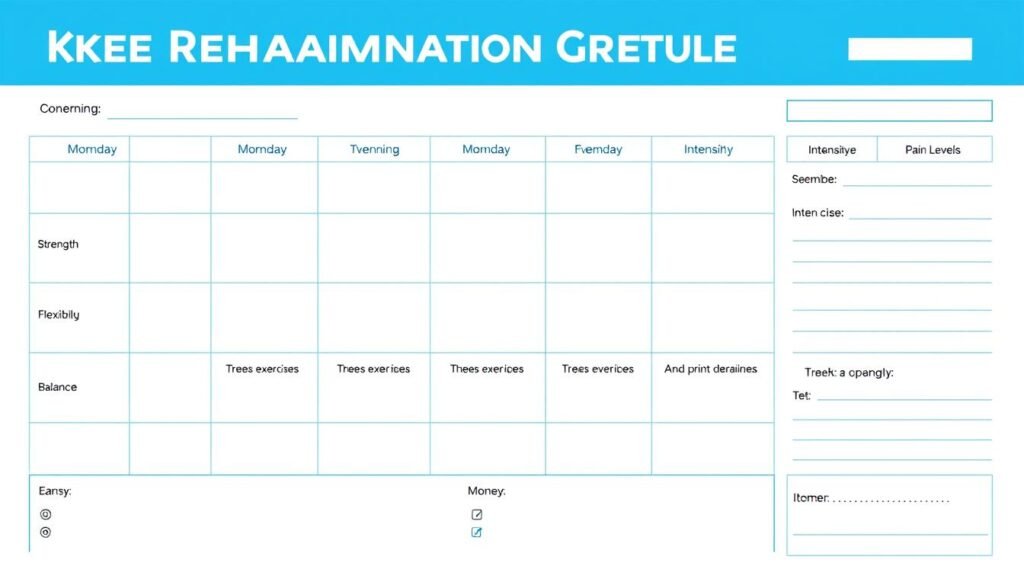
Sample weekly schedule for knee rehabilitation exercises
Sample Weekly Schedule
| Day | Early Stage | Intermediate Stage | Advanced Stage |
| Monday | All exercises: 3 sets each Ice after completion |
Strength exercises: 3 sets each Stretching: all stretches |
All strength exercises Balance training Stretching |
| Tuesday | Range of motion exercises Gentle walking if approved |
Light cardio (if approved) Stretching only |
Cardio training Stretching only |
| Wednesday | All exercises: 3 sets each Ice after completion |
Strength exercises: 3 sets each Stretching: all stretches |
All strength exercises Balance training Stretching |
| Thursday | Range of motion exercises Gentle walking if approved |
Light cardio (if approved) Stretching only |
Cardio training Stretching only |
| Friday | All exercises: 3 sets each Ice after completion |
Strength exercises: 3 sets each Stretching: all stretches |
All strength exercises Balance training Stretching |
| Weekend | Range of motion exercises Rest and ice as needed |
One day of light exercise One day of rest |
One day of light activity One day of rest |
Tracking Your Progress
Keeping a record of your exercises and progress helps you stay motivated and provides valuable information for your healthcare provider. Consider tracking:
- Exercise Completion: Which exercises you performed and how many sets/repetitions
- Pain Levels: Rate your pain on a scale of 0-10 before, during, and after exercises
- Range of Motion: Track improvements in how far you can bend or straighten your knee
- Swelling: Note any changes in swelling before and after exercise
- Functional Improvements: Record milestones like walking without a limp or climbing stairs
Tracking your progress helps maintain motivation and provides valuable feedback
When to Progress to the Next Phase
Advancing to the next phase of exercises should be based on your recovery milestones, not strictly on time. General guidelines for progression include:
- Early to Intermediate: Minimal swelling, improved range of motion, ability to bear weight comfortably
- Intermediate to Advanced: Good strength in basic exercises, stable knee during simple activities, minimal pain with daily activities
- Return to Full Activity: Normal strength compared to unaffected leg, full range of motion, confidence in knee stability
Always consult with your healthcare provider before advancing to a new phase of rehabilitation.
Supporting Recovery Through Nutrition
Proper nutrition plays a vital role in knee injury recovery. Certain nutrients can help reduce inflammation, support tissue repair, and optimize healing.
Key nutrients that support knee injury recovery and rehabilitation
Key Nutrients for Recovery
Protein
Essential for tissue repair and muscle rebuilding. Aim for lean sources like chicken, fish, beans, and low-fat dairy products.
Omega-3 Fatty Acids
Help reduce inflammation and support joint health. Found in fatty fish (salmon, mackerel), walnuts, flaxseeds, and chia seeds.
Vitamin C
Crucial for collagen production and tissue repair. Abundant in citrus fruits, bell peppers, strawberries, and broccoli.
Calcium and Vitamin D
Support bone health and muscle function. Sources include dairy products, fortified plant milks, leafy greens, and moderate sun exposure.
Antioxidants
Help combat oxidative stress during recovery. Found in colorful fruits and vegetables, especially berries, dark leafy greens, and orange/yellow produce.
Hydration
Proper hydration is essential for optimal tissue healing and joint function. Water helps transport nutrients to healing tissues and removes waste products. Aim for at least 8-10 cups of water daily, more if you’re exercising or in hot weather.
Recovery Nutrition Tip: Consider eating a small protein-rich snack within 30 minutes after completing your rehabilitation exercises to support muscle repair and growth.
Frequently Asked Questions
How long will it take to recover from a knee injury?
Recovery time varies greatly depending on the type and severity of your injury, your age, overall health, and how consistently you follow your rehabilitation program. Minor sprains may heal in 2-4 weeks, while surgical repairs can take 6-12 months for full recovery. Your healthcare provider can give you a more specific timeline based on your individual situation.
Is it normal to feel pain during knee rehabilitation exercises?
Mild discomfort during exercises is normal, but sharp pain is not. Use the “pain rule of thumb”: if pain is greater than 5 on a scale of 0-10, or if it persists for more than two hours after exercise, the activity was too intense. Adjust by reducing repetitions, resistance, or range of motion. Always communicate with your healthcare provider about pain during rehabilitation.
How often should I perform my knee rehabilitation exercises?
This depends on the specific exercises and your stage of recovery. Generally, range of motion and gentle stretching exercises can be performed daily, sometimes multiple times per day. Strengthening exercises typically require 24-48 hours of rest between sessions for the same muscle group. Your physical therapist will provide specific frequency recommendations for your situation.
When can I return to sports or regular exercise after a knee injury?
Return to sports should be gradual and based on functional milestones, not just time elapsed. Generally, you should have full range of motion, near-normal strength (compared to your uninjured leg), good balance and coordination, and minimal or no pain before returning to sports. Your healthcare provider should clear you for specific activities and may recommend a phased return to play.
Do I need special equipment for knee rehabilitation exercises?
Many effective knee rehabilitation exercises require little or no equipment, especially in the early phases. As you progress, basic items like resistance bands, light ankle weights, a stability ball, or a foam roller can be helpful additions. Your physical therapist can recommend specific equipment based on your needs and recovery goals.
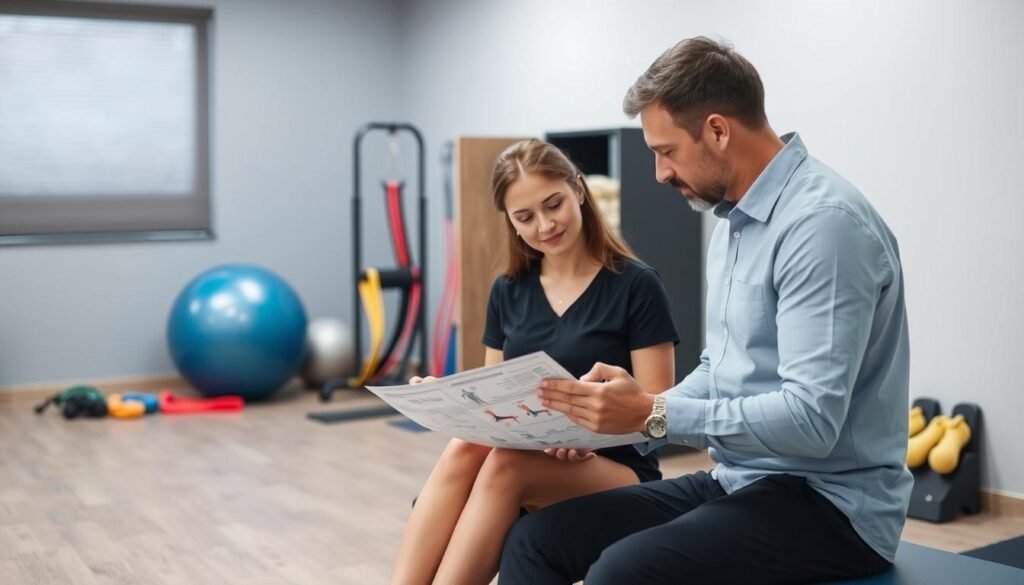
Consulting with a physical therapist ensures your rehabilitation program is tailored to your specific needs
Conclusion
Recovering from a knee injury requires patience, consistency, and proper technique. By following a structured progression of exercises—from gentle range of motion activities to advanced functional movements—you can rebuild strength, restore flexibility, and return to your normal activities safely. Remember that every injury is unique, and your recovery timeline may differ from others. Listen to your body, follow your healthcare provider’s guidance, and stay committed to your rehabilitation program.
The exercises outlined in this guide provide a framework for knee rehabilitation, but they should be tailored to your specific injury and needs. Regular communication with your healthcare team ensures that your program evolves appropriately as you progress through recovery.
Need Personalized Guidance for Your Knee Recovery?
Our experienced physical therapists can create a customized rehabilitation program specifically for your knee injury, ensuring safe and effective recovery. We’ll monitor your progress, adjust exercises as needed, and help you achieve optimal results.
